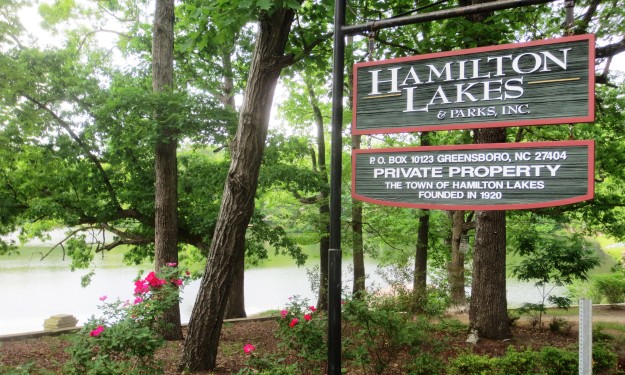A Brief History of Our Charming Neighborhood

Hamilton Lakes was originally developed in the 1920s. Alfred M. Scales, who had already helped to develop Greensboro’s upscale Irving Park neighborhood, sought to make his “dream of a beautiful village of homes” come true. With his land secured, he set out to create a resort-like community to accommodate the growing demand by middle and upper-income residents for large lots in a bucolic and relaxing setting. By 1927, he had laid out lots, streets, two lakes, and a golf course. He incorporated the Town of Hamilton Lakes and Scales himself served as the town’s mayor. Only a few fine lakefront homes, including Scales’ 11,000 square foot Neoclassical Revival style mansion facing Lake Hamilton and backing up to Lakewood Drive, were built in the 1920s. The Scales Property Company, held the land area comprising what is now Starmount Forest and Country Club, Friendly Acres, Guilford Hills, Garden Homes, Forest Valley, Green Valley Office Park, Green Valley, Westwood, Hamilton Lakes, Hamilton Forest, and Starmount Farms.
In the years that followed, Edward and Blanche Sternberger Benjamin acquired the land. It wasn’t until after World War II that Scales’ dreams for the neighborhood began to materialize, albeit on a more modest scale.
The town of Hamilton Lakes was annexed by the City of Greensboro in 1957. However, the Hamilton Lakes and Parks Association maintains its own parks and walking trails by means of association dues and other voluntary member contributions.
Starmount Forest was platted in the mid-1920s as part of the Hamilton Lakes subdivision. The neighborhood was cut from the eastern part of Hamilton Lakes by local developers Edward and Blanche Sternberger Benjamin in 1927. Building began in earnest after the close of World War Il and includes the Starmount Country Club, a focal point of both Starmount Forest and Hamilton Lakes subdivisions.
Curving streets and the presence of streams and mature trees characterize Starmount’s landscape. A naturalistic park is located at the neighborhood’s south end, on the south side of Starmount Drive. The neighborhood does not have sidewalks; concrete drainage swales run parallel with the streets.
Starmount Forest developed quickly in the years following World War II, resulting in the homogeneity of style, form, and detail. The housing of Starmount Forest is mostly brick, well-detailed, yet modest in size. The majority of dwellings are one or one-and-one-half-story
“Cape Cod” form houses. Two-story dwellings are concentrated on Madison Avenue, which transverses the neighborhood from east to west.
The predominant style is Minimal Traditional, defined as side-gable or gable-and-wing dwellings with Colonial Revival details such as door surrounds with broken pediments and pilasters, six-over-six or eight-over-eight windows with shutters, dormers, and Chippendale balustrades. As one travels north toward West Friendly Avenue, ranches and split-level houses are interspersed with the predominant Minimal Traditional dwellings. The details of these 1950s and 60s-era houses display a preference for the Colonial Revival.
Starmount Forest has a high degree of physical integrity in terms of both landscape and architecture. Houses are in good to excellent condition and retain much original material and detail. While some houses have been expanded with additions, they are generally in keeping with the character of the neighborhood.
The development patterns on Friendly Avenue amongst the Starmount, Hamilton Lakes, and Hamilton Forests neighborhoods have changed little since the 1950s and 1960s. Where additions to original houses have occurred, most have been to the rear of the house, leaving the viewshed from Friendly Avenue intact.
The proposed change in zoning affects the integrity of the neighborhood through the loss of tree canopy, front yard setbacks, and orientation of proposed townhome homes inward towards the development. Rezoning in turn would cause the loss of preservation of the historical significance of the surrounding neighborhoods as well as the homes that line Friendly Avenue.
Below is a synopsis of the historical restrictions placed on parcels in the Starmount Forest, Hamilton Lakes, Hamilton Forest, and Friendly Acres neighborhoods imposed by the Starmount Company.
- Property used for residential purposes only
- Standards for subdivision include minimum lot sizes and either a) minimum lot widths or b)
- Minimum lot frontages for the newly created lots
- Minimum square footage (commonly around 1000 sq.ft.) for principal dwellings or minimum
- Construction costs for the principal dwelling
- Minimum front yard setbacks (commonly 100-125 feet from property lines)
- Orientation of the main building/home toward the primary road
- Limits on fencing and creation of new roadways through existing parcels
These restrictions were envisioned to frame the initial development of the area and they eventually expired.
Part of what makes this area of Greensboro attractive and unique to incoming residents as well as lifelong Greensboro residents is the preservation of our historic neighborhoods.
Homes along Friendly Avenue from Westridge Rd to Holden Road currently have an application on file with the City of Greensboro to preserve its historical integrity through the creation of a neighborhood conservation overlay (NCO) similar to the NCO developed along Westridge Road. An NCO would prevent future developers from buying up single-family lots along Friendly Avenue and turning them into multi-family residential areas thus preserving our historically established single-family neighborhoods.
Sources
https://www.greensboro-nc.gov/home/showpublisheddocument/8589/636510647144300000
